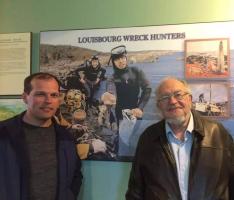
Alex Storm, right, with his son Jason Storm, Photo: THE CANADIAN PRESS/HO – Jason Storm
Alex Storm, a Canadian treasure hunter who discovered two valuable 18th-century shipwrecks off the shores of Nova Scotia, died last month at the age of 80.
In 1965, Storm and two associates discovered the wreck of Le Chameau, a French Navy ship which went down off the Fortress of Louisbourg in a storm in 1725 with the loss of more than 300 lives. The ship, bound for Quebec, then still part of French Canada, was also carrying money to pay for the French garrisons and other colonial expenses. Storm and his group recovered 7,861 silver coins and 878 gold Louis d’or from the wreck site. The discovery was the largest find in Canadian history.
In 1968, Storm located the remains of HMS Feversham, a British warship, part of a fleet sent to attack Quebec, which was shipwrecked in 1711, with the loss of 102 lives.
From Alex Storm’s obituary in The National Post:
Alex Storm was born to Dutch parents on October 2, 1937, in Surabaya, Java, Indonesia. During the Second World War he and his family were imprisoned in Japanese internment camps. After the war, they settled in the Netherlands.
In 1959 Storm emigrated to Canada in search of job opportunities and settled at Louisbourg on Cape Breton Island, where he became interested in the story of Le Chameau.
He worked on a fishing boat and in his spare time would dive for scrap metal from the hundreds of shipwrecks in the area.
After the discoveries which made headlines, Storm continued to salvage artifacts from shipwrecks, writing about his adventures in Canada’s Treasure Hunt (1968) and Seaweed and Gold (2003).
In 1964 he married Emily Lawrence, and in 1977 they opened a museum of artifacts in their home.
She predeceased him and he is survived by four sons and a daughter.
Thanks to Alaric Bond and Phil Leon for contributing to this post.
